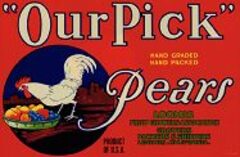Subscribers get free shipping, discounts and
more special offers and money saving coupons.
Subscribe Below:
Sponsor:
37328
Articles about crate label advertisers
 The Loomis Fruit Growers Association
The Loomis Fruit Growers Association
July 2001
An Appreciation of the Past
The first inhabitants of the Loomis Basin area were indigenous tribes living in small villages along the creeks and streams. The Maidu Tribe of the Penutian Empire, the predominant tribe in the Basin, subsisted primarily on acorns from the native oaks of the region. By 1825, trappers and hunters had discovered the Basin while traveling down the river they called the “Rio de los Americanos,” now known as the American River. Through the early part of the 1800s, the Basin was inhabited by only a few lone pioneers.
After the discovery of gold in the Sierra Nevada foothills in 1849, prospectors swarmed into the area and small mining camps sprang up. Between the gold rush and the organization of the County of Placer in 1851, the Basin experienced an influx of miners, farmers and businessmen. By 1850, a busy mining camp was established near the intersection of Horseshoe Bar Road and Secret Ravine. The community called itself “Pine Grove,” and by 1860 had enough settlers to apply for a post office. After being told that there was already an established town in Amador County named Pine Grove, the community named its post office “Placer” in 1861. The first of many granite quarries began operation in the nearby areas of Rocklin and Penryn in the same year.
The Central Pacific Railroad began constructing a railroad through the region about this time, and in 1864 it was extended through Placer County near Horseshoe Bar Road. The mining camp decided to move its few buildings to Loomis’ present downtown site near the railroad tracks, and rename itself “Pino.” However, because of its similarity to Reno, Nevada, mail, express and freight were often misdirected or misrouted; and in 1890, the community decided to change its name to “Loomis.” The name derived from Jim Loomis, one of the original pioneers. Jim served in all local public offices over time, including railroad agent, express agent, postmaster, and saloon-keeper. He was not very progressive and, it is said, kept the letters and mail matter in a cigar box on the end of the saloon bar for residents to sort through themselves. As the story goes, when a United States inspector objected to this method of handling a post office for the government, Jim picked up the cigar box, mail included, and tossed it into the street!
Toward the end of the century, life in the small community began to change. A town lot sale was held; roads were extended toward the American River and the ridge on the west, and the community began to develop into a town. Stone quarries were opened near the railroad station, and local farmers began planning fruit orchards. The completion of the Central Pacific Railroad over the Sierra Nevada in 1872 established an overland route for markets in the eastern states to receive fruit cultivated by Basin farmers. By 1880, considerable acreage had been planted in fruit orchards and many of the early mining ditches were used for irrigation water. The Loomis Fruit Growers Association was established in 1901 to provide fruit packing and transport services for local fruit ranchers. A group of progressive farmers
started the Bank of Loomis in 1915, and by the 1920s Loomis had become the second-largest fruit shipping station in the County, after Newcastle.
A large fire destroyed most of the downtown business core in 1915. By the early 1920s, almost every destroyed building in Loomis had been rebuilt with brick, concrete or tile, including the Town’s bank, veterinary stables, fruit-shipping warehouse, butcher shop and community churches. Outside of the downtown core, large orchards of budded and grafted fruit stock still spanned the countryside.

